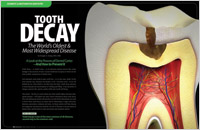 Fluoride, a naturally occurring mineral, is essential for proper tooth development and the prevention of tooth decay. In communities throughout the United States, tooth decay may still be a significant problem — but it is far less prevalent than it would have been, if not for the fluoridation of public water supplies. That's why the major associations of pediatric dentists and doctors support water fluoridation to the current recommended levels of 0.70 parts per million (ppm). It's also why the federal Centers for Disease Control and Prevention (CDC) has called fluoridated water one of the most significant health achievements of the 20th century.
Fluoride, a naturally occurring mineral, is essential for proper tooth development and the prevention of tooth decay. In communities throughout the United States, tooth decay may still be a significant problem — but it is far less prevalent than it would have been, if not for the fluoridation of public water supplies. That's why the major associations of pediatric dentists and doctors support water fluoridation to the current recommended levels of 0.70 parts per million (ppm). It's also why the federal Centers for Disease Control and Prevention (CDC) has called fluoridated water one of the most significant health achievements of the 20th century.
Of course, not everyone has access to fluoridated water. That's one reason why we sometimes recommend a fluoride supplement for your child and/or the use of toothpastes and other products that contain this important mineral. Because it is possible for children to get too much fluoride, it is best to consult with us on the use of any fluoride-containing product.
How Fluoride Helps
The protective outer layer of teeth, called enamel, is often subject to attacks from acids. These can come directly from acidic foods and beverages, such as sodas and citrus fruits — or sometimes through a middleman: the decay-causing bacteria already in the mouth that create acid from sugar. These bacteria congregate in dental plaque and feed on sugar that is not cleansed from your child's mouth. In metabolizing (breaking down) sugar, the bacteria produce acids that can eat through tooth enamel. This is how cavities are formed. When fluoride is present, it becomes part of the crystalline structure of tooth enamel, hardening it and making it more resistant to acid attack. Fluoride can even help repair small cavities that are already forming.
Delivering Fluoride to the Teeth

Fluoride ingested by children in drinking water or supplements can be taken up by their developing permanent teeth. Once a tooth has erupted, it can be strengthened by fluoride topically (on the surface). Using a fluoride-containing toothpaste is one way to make sure your children's teeth receive helpful fluoride exposure daily. We recommend using only a pea-sized amount for children ages 2-6 and just a tiny smear for kids under two. Fluoride should not be used on children younger than six months. A very beneficial way to deliver fluoride to the teeth is with topical fluoride applications right here at the dental office. We can paint it right onto your child's freshly cleaned teeth and let it sit for a few minutes for maximum effectiveness.
How Much Is Too Much?
Teeth that are over-exposed to fluoride as they are forming beneath the gum line can develop a condition called enamel fluorosis, which is characterized by a streaked or mottled appearance. Mild fluorosis takes the form of white spots that are hard to see. In more severe cases (which are rare), the discoloration can be darker, with a pitted texture. The condition is not harmful, but may eventually require cosmetic dental treatment. Tooth decay, on the other hand, is harmful to your child's health and can also be quite painful in severe cases.
The risk for fluorosis ends by the time a child is about 9 and all the permanent teeth have fully formed. Until then, we would be happy to discuss with you how much fluoride your child needs and in what form. Since fluoride use is cumulative, we need to take into account all the sources your child comes in contact with — including powdered infant formula mixed with fluoridated tap water — along with sugar consumption and other risk factors for decay, to make the appropriate recommendation. But while caution is advised, it would be a mistake to forgo the benefits that this important mineral can bring to your child's teeth — and his or her overall health.
Related Articles

Fluoride and Fluoridation in Dentistry The Center for Disease Control says that water fluoridation is "One of the ten most important public health measures of the 20th century." Extensive systematic reviews of the evidence conclusively show that water fluoridation and fluoride toothpastes both substantially reduce dental decay. Learn why through the amazing fluoride story... Read Article

Topical Flouride Fluoride has a unique ability to strengthen tooth enamel and make it more resistant to decay. That's why dentists often apply it directly to the surfaces of children's teeth after routine dental cleanings. This surface (topical) application can continue to leach fluoride into the tooth surface for a month or more... Read Article

Tooth Decay — A Preventable Disease Tooth decay is the number one reason children and adults lose teeth during their lifetime. Yet many people don't realize that it is a preventable infection. This article explores the causes of tooth decay, its prevention, and the relationship to bacteria, sugars, and acids... Read Article
